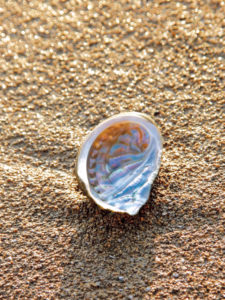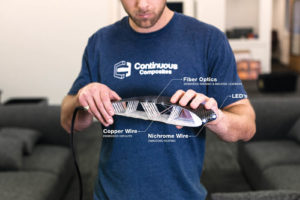
In material science, strength alone is often found to have its limitations; a combination of hard and soft, rigid and flexible is an area of increasing interest for a wide range of applications from construction, to sports equipment, to protective apparel.
Composites bring together two or more materials to provide one that has novel features, generally with the purpose of enhancing performance and making it an ideal form to combine qualities.
Strength through biomimetics
Biomimicry and digital technologies are individually making advances, but the increase in data processing capabilities is set to be the real game changer in aligning these fields more effectively. One textile specialty, found in the Kyoto region of Japan, is a fine quality of silk overlaid with the thinnest hand-cut sliver of abalone shell. Although one of the strongest materials found in nature, it is used here for its shimmering decorative qualities. The process of creating the textile is extraordinarily labor-intensive and highly skilled, making it a highly valued and valuable fabric used in special kimonos and obi.
The abalone has attracted the attention of material scientists, however, because of its strength rather than aesthetics. It’s been featured in almost every biomimicry book written about the extraction of good design from nature; however, commercial products based on its structure have proven to be elusive. Recently published research suggests this may be about to change.
Researchers at the University of Massachusetts and Washington University (St. Louis) have developed a nacre-mimetic composite capable of withstanding extreme mechanical forces. “Nacre” refers to the abalone shell and “mimetic” is an abbreviation of the term biomimetic.
The researchers have brought together silk fibroin and graphene oxide flakes to fabricate a nanocomposite with a unique multilevel and hierarchical structure. In tests it was found that there is a considerable difference in specific penetration energy where the graphene oxide flakes evolve from isolated sheets that do not interact to partially overlapping, continuous sheets.

The study concludes that the morphologies of nanoscale constituents and their interactions are critical to the scalability of nacre-mimetic nanocomposites of this type. Testing is a vital part of the development process in these new biomimicry composites, and often serves as a reminder of the unique challenges that material scientists face.
Nano-layered composite (NLC) structures involve one process under consideration as a way of producing nacre-mimetic materials. NLC structures are being tested for fatigue by researchers at Northeastern University in Boston and the Chinese Academy of Sciences (Shenyang). Looking specifically to overcome issues of structure fatigue in the composite, the researchers are finding some success in the use of a layer-by-layer self-assembly and chemical bath deposition production process. Testing includes examining the elastic modulus, hardness, fracture toughness, strain amplitude and fatigue limits.
Fiber-laying innovations
The increasing cost of specialist, high-performance fibers, coupled with the demand for high-strength, low-weight composites, has led to innovative developments in the techniques of fiber-laying technologies. Niche applications have helped raise the profile and drive developments in this arena.
Michigan-based LayStitch™ Technologies produces a number of machines with these capabilities. The company’s FiberPrinter™ lays out the fiber tow or roving for carbon fiber composites, with the fiber then attached by stitching to a substrate, often a nonwoven that can be removed later in the process. It is used across a range of industries from prosthetics to automotive parts.
German manufacturer TFP Technology GmbH works with an automated tailored fiber placement technology (TFP). While most composite manufacturers are keen to emphasize their advanced technologies, TFP Technology acknowledges its debt to embroidery as “one of the oldest and highest quality textile-refining and production techniques.” The system is capable of working with carbon fiber with a thickness range of 3K–50K as well as glass fiber, aramid, steel, basalt and ceramic.
Idaho-based Continuous Composites has developed a technology that brings together composites with 3-D printing in a technology that it has patented as Continuous Fiber 3-D Printing (CF3D™). As the fiber is laid, the rapidly curing UV-cure resin is applied without the need for a mold. This offers significant cost and space savings, as well as allows novel forms to be created that would not be possible using more conventional composite manufacturing processes.
Different high-performance yarns, such as carbon fiber and glass fiber, can be used. Additional functionality can be introduced during the fiber-laying process, which may include fiber optic sensors, copper and nichrome wires. These effectively make the material a smart composite, capable of sensing its environment and collecting data, conducting electricity to power LEDs or heating elements, for example. Reducing the number of stages in producing the finished composite offers greater production and environmental efficiencies with these two processes coming together.
When glass fiber first became available, though excited by the possibilities, manufacturers complained that their looms struggled with the new fiber and endured frequent stoppages in production, which made it expensive—prohibitively so for many potential applications. Technological development does not conveniently occur in a synchronized way, then or now. That said, the push toward Industry 4.0 means that manufacturers have to engage with developments in associated areas. For composite manufacturers, this can extend to emerging trends in design software and artificial intelligence (AI).
Adapting and evolving
At the recent Smartgeometry 2018 conference in Toronto, Ont., Canada, David
Benjamin, founding principal of The Living, an Autodesk® studio based in New York, spoke of the potential for generative design to manage complexity. In generative design, nature’s own ability to adapt and evolve is mimicked. The software system allows designers and engineers to generate thousands of solutions before selecting the one that best suits their needs.
Different requirements and constraints can be loaded into the system, so that in composite terms, for example, the trade-off between strength and flexibility can be assessed, introducing additional criteria such as weight or cost to the evaluation process. While manufacturers already engage with other suppliers and stakeholders, in generative design, the computer also becomes one of the co-designers, utilizing skills of data visualization and machine learning to create insights. In proffering multiple design possibilities, the software tests and learns from each iteration so that it becomes a form of (digital) prototyping at a pace that would not be possible within a more conventional system.
Looking to the future, one of Benjamin’s projects is titled Bio Computational Evolution: The Next Generation of Software for Synthetic Biology. The project explores the intersection between synthetic biology, architecture and computation using Autodesk Maya® and bespoke scripts. The aim: to create a new field of composite materials with unique properties.
Marie O’Mahony is an industry consultant, author and academic. She is the author of several books on advanced and smart textiles published by Thames and Hudson, and is a visiting professor at the Royal College of Art (RCA), London.
 TEXTILES.ORG
TEXTILES.ORG


